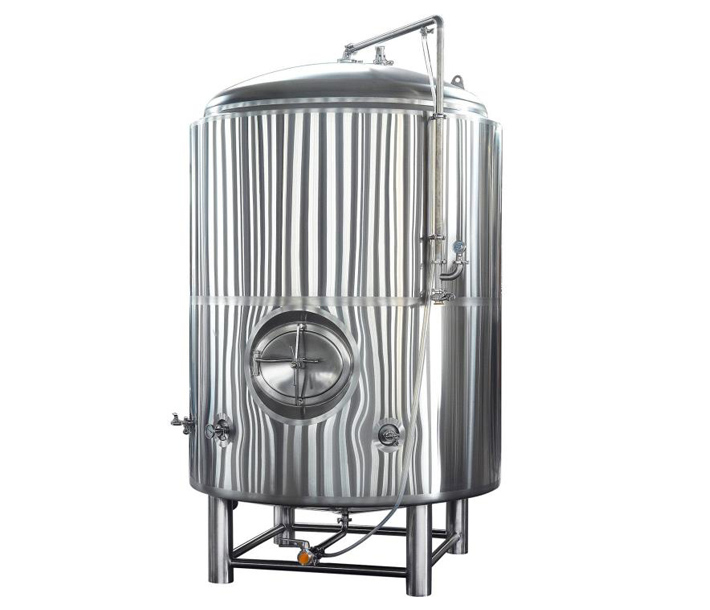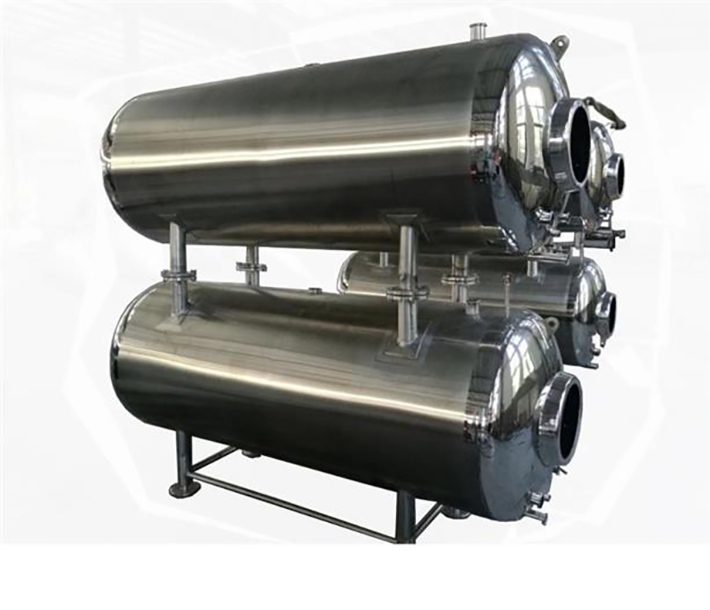Bright Beer Tank
What is Bright tank?
Bright Tank is a dish-bottomed pressure-rated temperature-controlled tank used to hold beer in preparation for packaging. The term “bright” refers to “bright beer,” beer that has been rendered bright (clear) by filtration, centrifugation, fining, and/or maturation. In most breweries, beer will be filtered after leaving a uni-tank or lagering vessel and be directed into a bright tank. If the beer is to be force-carbonated, then the beer may be carbonated in-line, under pressure, between the fermenter or lagering tank and the bright tank.Bright tanks are also sometimes used as mixing tanks for beers that are to be bottle-conditioned. Here, the beer will be mixed with priming sugar and possibly with new yeast intended to carry out re-fermentation. The beer is then bottled (or, in rare instances, kegged) from the bright tank. In brewpubs, the bright tank is often also the serving tank; beer may run directly from this tank to the taps at the bar.


We fabricate our vessels to the highest level of craftsmanship and build quality that will compare favorably to anything on the professional brewing equipment market. All of our vessels are pressure tested, 100% sanitary welded, Pickling passivation, jacketed and insulated.
Technical details
- Head space: 20% over stated size
- Material: Stainless steel 304/316
- Inside surface: SUS304, TH:3mm
- Outside surface: SUS304,TH:2mm
- Thermal insulation material: Polyurethane (PU) foam, Insulation thickness: 80MM.
- Polishing coefficient: 0.4µm without dead corner.
- Manhole: Side manhole
- Design pressure 3Bar, Working pressure: 1.5-2Bar
- Bottom design: 140degree cone for easy to exist yeast.
- Cooling method: Dimple cooling jacket(Cone and cylinder 2 zone cooling),
- Cleaning system: Round rotary cleaning ball.
- Control system: PT100, temperature control;
- CO2 adding device on side.
- With:PVRV, coolant inlet/outlet, PT100 interface, CIP arm with spray ball, pressure gauge, Mechanical pressure regulating valve, sanitary sampling valve, breath valve, drain valve, level display, etc.
- Stainless steel legs with bigger and thicker base plate, with screw assembly to adjust leg height;
- Complete with associated valves and fittings.
Production requirements:
- Welding: We abandoned the argon gas cylinder but adopt The Central System of Argon to make sure the TIG welding with pure argon gas shield. We also increase the using amount of gas when welding, so the quality of the welding line is higher.
- Dimpling: We adopt a dimple plate rather than a belt for glycol jacket since it can increase the cooling area and improve the speed of cooling. The most important thing in the brewing process is to avoid contaminating, that is to say the most important thing in producing beer equipment is to polish the inside tanks to 0.4~0.6 μm without dead corner.
- Polishing: We use large-scale polishing equipment to polish the inside of the tanks -- all over the wall to make sure there is no dead corner. You need not worry about there will be some bacterias remained after cleaning.

Raw material SUS 304/316

Insulation TH: PU 80mm

Polishing: 0.4-0.6μm

Pickling and passivation

Dimple cooling jacket

Mirror polished inside

Beer outlet

Side manhole

CIP cleaning spray ball

Pressure relieve valve

Pressure gauge

Foam breaker

Butterfly valve

Breath valve

Sample valve

Clamp

Thermometer

Solenoid valve

Carbonation stone

Drain outlet

PT 100 temperature

Cooling inlet and outlet

Lifting ear

Adjust legs
1How should I choose BBT?
You can decide the size of BBT according to the production capacity of the brewery, make a plan for how many liters of beer BBT needs to store every day, and choose the number of BBT according to the number of types of beer.
2How to operate Bright tank correctly?
We check the CO2 levels in the beer stored in bright tanks every day. It’s a good way to find out if your pressure relief valve [PVRV] or some other valve is leaking. Try to maintain constant CO2 pressure in the head space on the beer. Altering the pressure changes the carbonation levels of the beer.
3How to clean and maintain the Bright tank during use?
If you find a good acid cleaner, you can leave the tank charged with CO2 during cleaning and not waste the gas. Caustic cleaners require the blow down of CO2 and re-gassing the tank to purify it after the cleaning. Caustic cleaners react with CO2, which then neutralizes the caustic. Also, when working with cleaning chemicals, we mandate safety goggles and elbow-length gloves.
